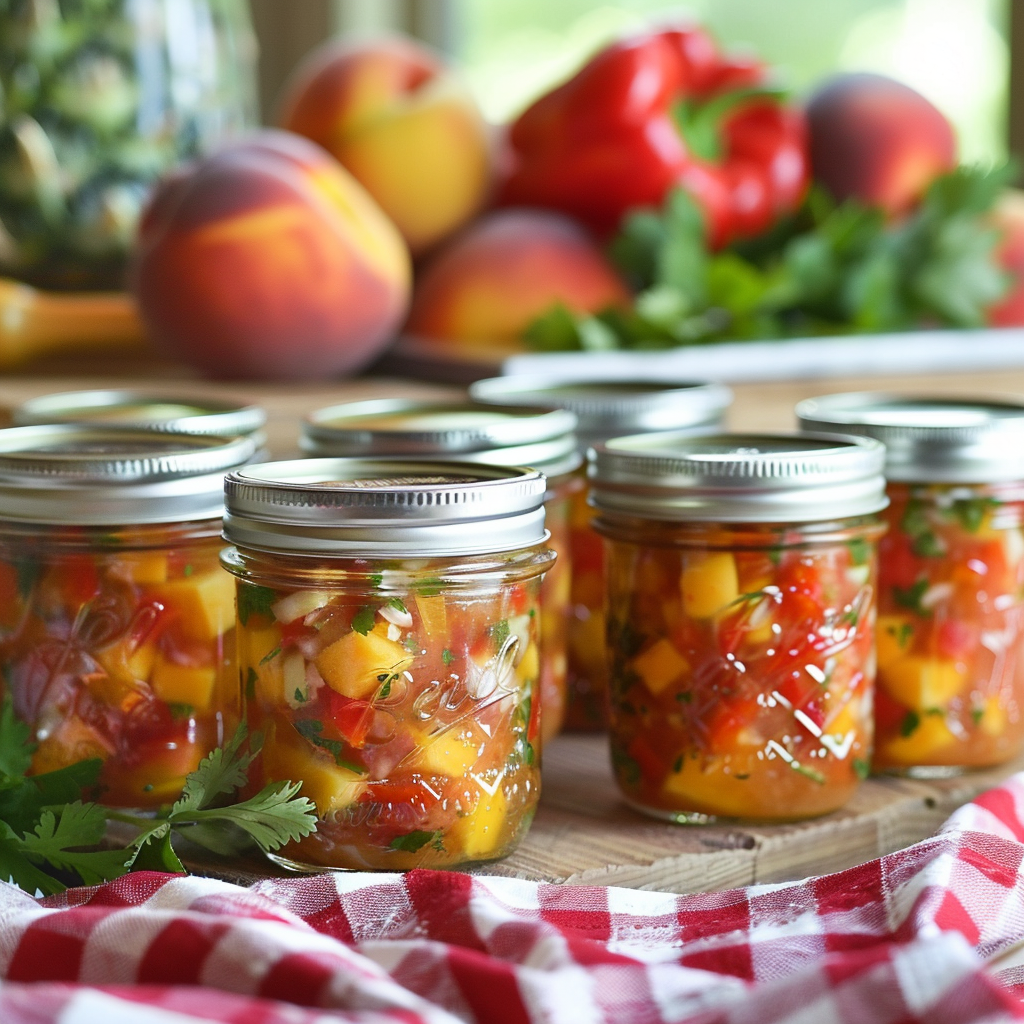How to Make and Can Peach Salsa: A Sweet and Spicy Twist on Tradition

Share
Peaches and Tomatoes Pare Up For A Tasty Salsa
Living on an orchard surrounded by rows of peach trees was a time in my life that truly connected me to the rhythm of nature. The bounty from those trees was both a blessing and a challenge, especially when the harvest was plentiful. That's when the idea of making peach salsa was born—a perfect blend of the orchard’s sweetness and the garden’s bounty. One summer, I invited a dear friend over, and together, we spent the afternoon peeling, chopping, and mixing, creating jar after jar of delicious salsa. Not only did we preserve the taste of summer, but we also created memories to share. Making salsa with a friend adds a layer of joy to the process, and sharing the fruits of your labor—literally—only makes it sweeter. Whether you have a garden full of produce or a single tree bursting with peaches, this recipe is a delightful way to capture the essence of summer.
Did You Know?
Peaches were first cultivated in China more than 4,000 years ago and were considered a symbol of immortality and unity. Today, they are loved worldwide for their sweet, juicy flavor and numerous health benefits, including vitamins A and C.
Yield: 7 pints
Ingredients:
6 cups chopped, peeled peaches (about 4 pounds)
4 cups chopped tomatoes (about 2 pounds)
2 cups chopped red bell peppers
1 cup chopped onions
1 cup chopped green bell peppers
4 jalapeño peppers, seeded and finely chopped
1 cup white vinegar (5% acidity)
1/2 cup chopped fresh cilantro
4 cloves garlic, minced
2 tablespoons honey or sugar
1 teaspoon ground cumin
1 teaspoon salt
Instructions:
1. Prepare the Jars:
Sterilize Jars: Wash jars, lids, and bands in hot, soapy water. Rinse well. Place jars in a large pot, cover with water, and boil for 10 minutes. Keep jars hot until ready to use.
Prepare Lids: Heat lids in simmering water (not boiling) until ready for use. Do not boil. Set bands aside.
2. Prepare the Peaches:
Blanch and Peel: Bring a large pot of water to a boil. Cut an "X" on the bottom of each peach. Blanch peaches in boiling water for 30-60 seconds, then transfer to ice water. Peel off skins.
Core and Chop: Remove pits from peaches. Chop peaches and set aside.
3. Prepare the Vegetables:
Chop Tomatoes and Peppers: Wash and chop tomatoes, red bell peppers, green bell peppers, onions, and jalapeño peppers.
4. Cook the Salsa:
Combine Ingredients: In a large pot, combine chopped peaches, tomatoes, bell peppers, onions, jalapeño peppers, vinegar, cilantro, garlic, honey, cumin, and salt.
Bring to Boil: Bring the mixture to a boil over medium-high heat, stirring frequently.
Simmer: Reduce heat and simmer for 10 minutes, stirring occasionally.
5. Pack the Jars:
Pack Salsa: Ladle hot salsa into hot jars, leaving 1/2-inch headspace.
Remove Air Bubbles: Run a non-metallic spatula around the inside of the jar to remove air bubbles.
Wipe Rims and Apply Lids: Wipe jar rims with a clean, damp cloth. Apply lids and screw bands until fingertip tight.
6. Process the Jars:
Boiling Water Bath: Place jars in a boiling water canner. Ensure they are covered by at least 1-2 inches of water. Process for 15 minutes for pint jars.
Cool Jars: Remove jars and place them on a towel to cool for 12-24 hours. Do not disturb while cooling.
Check Seals: After cooling, check seals. Lids should not flex up and down when pressed. Store in a cool, dark place for up to a year.
Freezer Method:
Prepare Salsa: Follow the same steps for cooking the salsa.
Cool and Pack: Let salsa cool completely, then pack into freezer-safe containers, leaving 1/2-inch headspace.
Freeze: Store in the freezer for up to 6 months.
Nutritional Information (Per Serving - 2 tablespoons of peach salsa):
Calories: 15, Protein: 0g, Carbohydrates: 4g, Fat: 0g, Sugars: 3g
Kitchen Tips, Great Ideas, How to Save Money:
1. Choose Fresh Peaches: Use ripe, firm peaches for the best flavor and texture. Avoid overripe or bruised fruit.
2. Blanching Tips: Blanching peaches makes peeling easier. Ensure water is at a rolling boil and blanch in small batches to maintain temperature.
3. Sterilization is Key: Always sterilize jars and lids to prevent contamination and ensure a long shelf life.
4. Vinegar for Safety: Vinegar increases the acidity of the salsa, which is crucial for safe canning. Always use vinegar with 5% acidity.
5. Honey or Sugar: Adding a bit of honey or sugar enhances the sweetness of the peaches and balances the acidity of the vinegar.
6. Headspace is Important: Leave the correct amount of headspace to allow for expansion during processing and to ensure a proper seal.
7. Remove Air Bubbles: Removing air bubbles prevents trapped air, which can lead to spoilage. Use a non-metallic utensil to avoid damaging jars.
8. Proper Sealing: Do not over-tighten lids. Fingertip tight is sufficient, allowing air to escape during processing.
9. Storage Conditions: Store canned salsa in a cool, dark place to maintain quality and prevent spoilage. Avoid storing near heat sources or in direct sunlight.
10. Labeling Jars: Always label jars with the date and contents. This helps keep track of inventory and ensures you use older jars first.
So, What Are the Best Varieties of Peaches for Salsa?
When it comes to making peach salsa, not all peaches are created equal. Some varieties are better suited for this sweet and spicy concoction. Here are two of the best options:
Freestone Peaches: As the name suggests, the pit or "stone" of these peaches comes away easily from the flesh, making them easier to prepare. Freestone peaches are juicy and flavorful, with a firm texture that holds up well in salsa.
Clingstone Peaches: These peaches have flesh that clings tightly to the pit, making them a bit trickier to prepare. However, their intense sweetness and slightly firmer texture make them a great choice for salsa, especially if you don’t mind a little extra work.
Yellow Peaches: The classic yellow peach is perfect for salsa. Its balance of sweetness and acidity pairs well with the heat of the jalapeños and the tang of the tomatoes, creating a harmonious blend of flavors.


